The Hotchkiss Revolving Cannon was designed by an American, Benjamin Hotchkiss, in response to the Franco-Prussian War. Hotchkiss chose to use large caliber shells in the gun instead of rifle cartridges (like the American Gatling or French Mitrailleuse) for greater anti-personnel effectiveness. The Congress of St Petersburg prohibited exploding ordnance with projectile weights under 14oz (because exploding bullets were deemed inhumane), so Hotchkiss based his design on a 16oz (37mm) cartridge.
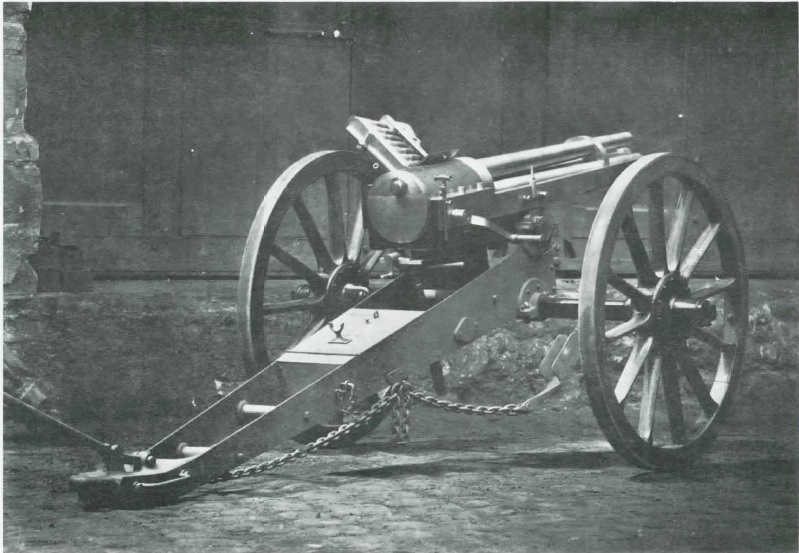
The mechanical design is fairly simple – the gun uses a single breechblock and firing mechanism, to which the barrel rotate one at a time. Each complete turn of the crank handle completes a firing cycle, with one round loaded, one fired, and one extracted. The mechanism is geared such that the crank handle us turned continuously, but the barrels are stopped and fixed during the actual firing process (this improves accuracy and can reduce the likelihood of jamming). Ammunition was fed via 10-round clips loaded by an assistant gunner.
During testing by the US Ordnance Board in 1876 and 1877, a total of 1,136 rounds were fired from a 37mm (1.5″) gun with only 5 malfunctions of any kind. One projectile failed to explode on impact, which was found be to the result of a broken firing in in the fuse. The other four malfunctions were light strikes early in the testing – the firing pin spring in the cannon was found to be faulty and replaced. After that repair, no more problems were recorded. That is an impressive performance for a repeating cannon in 1876, and the Ordnance officers were rightfully impressed. They were also impressed with the manufacturing quality and mechanical design of the gun – particularly how the barrels are set in place and not rotating while loading and firing occurs (unlike the Gattling gun and other contemporaries).
Primary use of the Hotchkiss revolving cannon was as navel armament, to defend large ships against smaller and much more agile torpedo boats. In this role, the Hotchkiss competed with other mechanical machine guns like the Nordenfelt and Gardner, but it was of a heavier caliber than the others. In addition to its original 37mm chambering, Hotchkiss cannons were also made in 47mm and 53mm in response to military demand. They were adopted by a number of nations including Brazil, France, China, the US, Holland, Greece, Chile, Argentina, Russia and Denmark.
Manuals
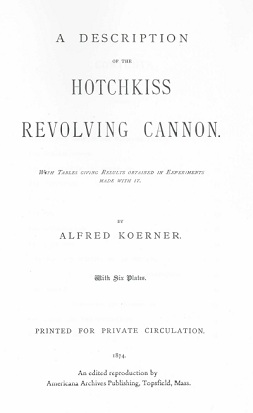
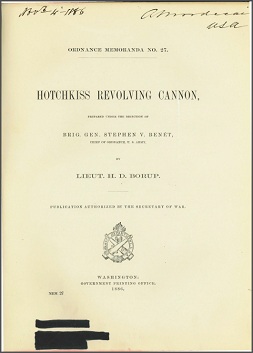
Photos
This Hotchkiss Revolving Cannon was captured from the ruins of the Spanish cruiser Vizcaya after the Battle of Santiago Bay in 1898. It was returned to the US by Captain Caspar Goodrich (USN) and put on display on a Gattling carriage at the Connecticut capitol building in Hartford (click here to download photos at high resolution).
Resources
You can find a gallery of several types of Hotchkiss revolving cannon and description of the different variants (as well as other early mechanical guns) at Victorian Ship Models.
We also have a testing report from US tests conducted at Sandy Hook New York in 1876 and 1877, which includes translated excerpts from French and Brazilian testing as well:
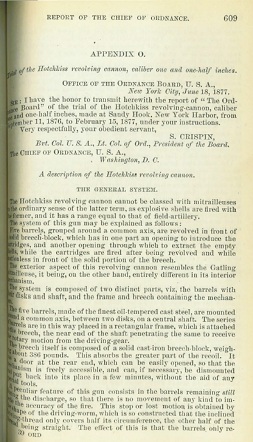

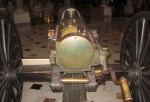
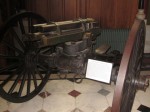
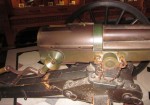


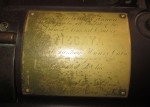

Add an electric engine…make it belt fed …chamber in modern cannon caliber…and you have a beast like the M61 Vulcan 🙂
It would be nice if someone will post manual on M61 Vulcan cannon..
Actually, it appears much more similar to the “chain-gun” used on attack helis of the post-Vietnam period.
Electric motor might have been impractical on a ship of that period, I’m envisioning a steam-driven version !
It seems there was an even more forgotten, single barrel 37mm Hotchkiss cannon, used by the Russian Navy after 1883, and mounted on some French WW1 airplanes.
The use in Russia is described here.
I think you can see one on the nose of a Breguet Bre.5 in this photo.
I wonder what the object suspended in parallel over the barrel is? Some kind of recoil damper?
I believe that single-barrel gun is not a variant of the rotating cannon, but rather a Puteaux development of a quick-firing 37mm (or 47mm) gun adapted to aerial use. The top cylinder would be the recoil buffer and spring. Chinn discusses this sort of thing in his book: http://www.ibiblio.org/hyperwar/USN/ref/MG/I/MG-5.html
Actually an electric motor would have be quite appropriate, given the abundance of propulsive force provided by conventional and steam turbine engines.
In fact, an electrically powered Gatling was tested as a shipboard weapon prior to WWI.
Yeah, it’s a little-known fact that the originator of the electrically powered Gatling concept was Richard Gatling himself.
Perfect for home defense. I have one sitting on my nightstand within easy reach of my artillery crew (Who lives inside the nightstand)…
It would seem that a H. revolving gun, could have been placed in a Renault with a larger turret to accommodate 3 men. With slightly larger engine. I don’t believe this would have been a big problem. Electric, hydraulic, or hand cranked, with a magazine holding 20-60 rds. would have been feasible. I am not an engineer, but it would have made a ferocious exploitation tank, not to mention a tank destroyer. I maybe niave, so how about some feedback.
The Renault would have had to be half again bigger to support the turret, maybe a full double it’s original size. Still, would have been a viscous thing for the era.
Combat in that era was close, so it would seem that it would have been an awesome vehicle.
Does anyone know if this 1800’s business card (use above ebay link to view the listing) is actually from the 1876 Centennial Exposition? Was this card given away to sell these weapons to militia and armies? Any help would be appreciated! – Thanks!
There are two of thease guns on display outside Texas County Genealogical and Historical Society in Huston Mo.
We just (10/15/2013) sold one of these for $90,000 US$ and currently have the only two in the world for sale that we know of! Please visit our website to see one!
There are two on display dated 1883 on the Eastern Shore of Virginia. I can be called at 757-787-9151. Look forward to hearing from you.
hmmmmmmmmmm, this is such a wonderfull design!! is there any chance of getting some copies of the original patent papers and engineering schematics?
You do not mention Mexico as a user? The gun appears in photographs, eg Casasola. Does anybody have any further information on the guns use in mexico, please?
Seems that this “naval” gun was used by the US Army to slaughter the Lakota at Wounded Knee. Sad history.
That was the Hotchkiss designed M1875 Mountain Gun, a completely different creature than the Hotchkiss Revolving Cannon.
https://www.militaryfactory.com/aircraft/detail.asp?aircraft_id=1972
It appears that the 37mm variety was used in this experimental aircraft during WWI–it’s a French design that looks exceptionally modern to me, but that did not work (the plane, not the gun).
The neighbor had a spent shell, and a dud round from one of those guns. The spent round was of high explosive type. We kids used to toss it back and forth. Had the shell exploded, it would have killed us all.